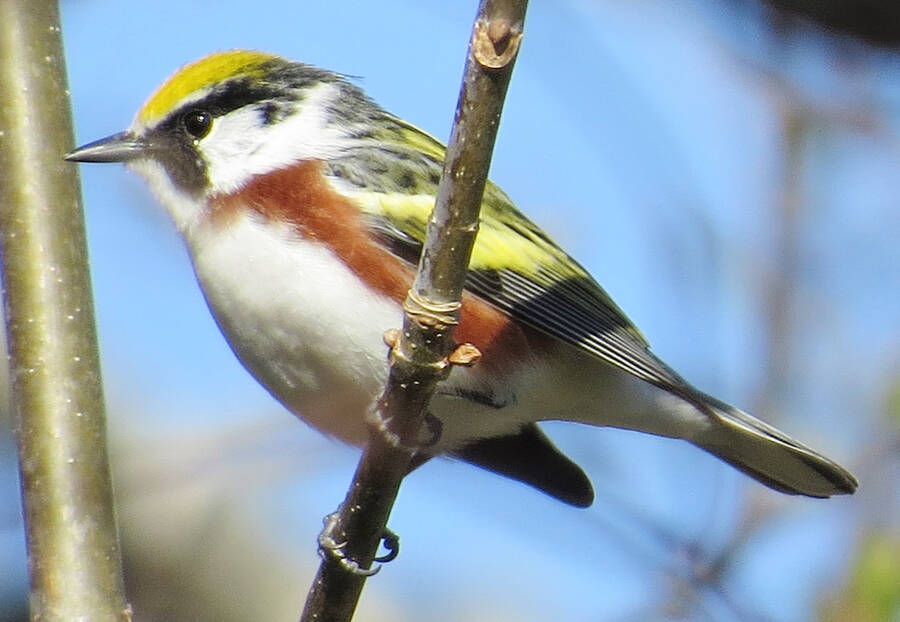
2022-06-29
Missing: The Chestnut-sided Warbler
On June 19th Dorothy Poole accompanied me as I did my annual breeding bird survey.
The survey runs from Jordan Falls into Shelburne, up into Welshtown and ends at Upper Clyde. This route has 50 stops of three minutes each. All birds heard and seen are recorded during the three minute period.
The stops are roughly just short of one kilometre apart. We ended up with 55 species.
Plentiful species included hermit thrush, gray catbirds, red-eyed vireos, ovenbirds and northern parulas. We were happy to find a pair of olive-sided flycatchers and Dorothy spotted a red-shouldered hawk, which I missed. We only had one common grackle and no red-winged blackbirds.
Usually we have numbers of black-throated blue warblers, but only one was documented this year. There were very few yellow warblers and common yellowthroats, where we usually have had many. The other warbler species that we did locate were in very low numbers. Many of the usual warbler species were not present, including the chestnut-sided warbler. This is the first time that we did not have any at all on the count.
The chestnut-sided warbler nests from Saskatchewan across Canada to New Brunswick and Nova Scotia and in North Dakota, Nebraska, Minnesota, Wisconsin, Michigan, Ohio, Maryland, Pennsylvania, New Jersey, New York, Massachusetts, Maine, Georgia, South Carolina, Iowa, Missouri, and Indiana. They winter from Nicaragua to Panama.
In the early 19th century the chestnut-sided warbler was considered a rare bird with Audubon himself only seeing it once. Eventually, it increased to become one of the most common warblers especially in the northern half of the U.S. and the Great Plains.
The chestnut-sided warbler is 11.25 to 13.13 cm long. It is the only warbler that is all white below, except for its broad stripe of chestnut on the sides. The male in breeding plumage has a lemon yellow crown and chestnut sides with a black eye-stripe and moustache. The female is similar with less chestnut on the sides and less black on the face.
There are two pale yellow-white wing bars, the eyes are dark brown and the legs and feet are slate blue. In the fall, the chestnut-sided warbler is olive-green above with a bold white eye-ring, a grey face and whitish below with yellowish wing bars.
The chestnut-sided warbler eats cankerworms, caterpillars of gypsy moths, small moths, small grasshoppers, spiders, and a few seeds or berries.
I recently read in Living Bird Spring 2022, Vol. 41, Issue 2, on page 36 an interesting article which referred to how the white-stripe and tan-striped form of the white-throated sparrow comes about.
There are actually four sexes. A male and female form of the white-striped and a male and female form of the tan-striped. So the white-striped male will only mate with the tan-striped female, producing white-striped birds. The tan striped male will only mate with the white-striped female, producing tan striped birds.
SPOTTINGS
Dorothy Poole saw two chimney swifts over her house in Port Medway. Greg Van De Moortele of Bridgewater had a bird hit his window with a large bang. He went out right away and saw the bird on the basement windowsill. Photos reveal the identity as a black and white warbler. This warbler recovered and flew off.
In Bridgewater, Alan Slauenwhite saw a northern flicker rooting out ants from under a block of cement. Alan reports that white-breasted nuthatches that were nesting there successfully fledged young ones.
In years past one would see large creches of juvenile common eiders with adults, and the juvenile birds numbering in the hundreds. This seems to be a thing of the past and is, a phenomenon that is being currently studied. On June 22, I saw four adults with only six small juveniles at Crescent Beach.
On June 14 a brown booby was photographed by Aldric d'Eon as it perched on the ship Atlantic Leader 8.5 km south of Cape Sable Island. On June 15 Mark Dennis reported a great egret and a snowy egret at Daniels Head on Cape Sable Island.
A wood stork was seen in New Harbour, Antigonish on June 15 by Stephen Flemming. This was the first photo documented record for this species in Nova Scotia. Historically there was supposed to have been one reported on Brier Island in the journals of a prominent birder from a very long time ago.
You may reach me at (902) 693-2174 or email jrhbirder@hotmail.com.







